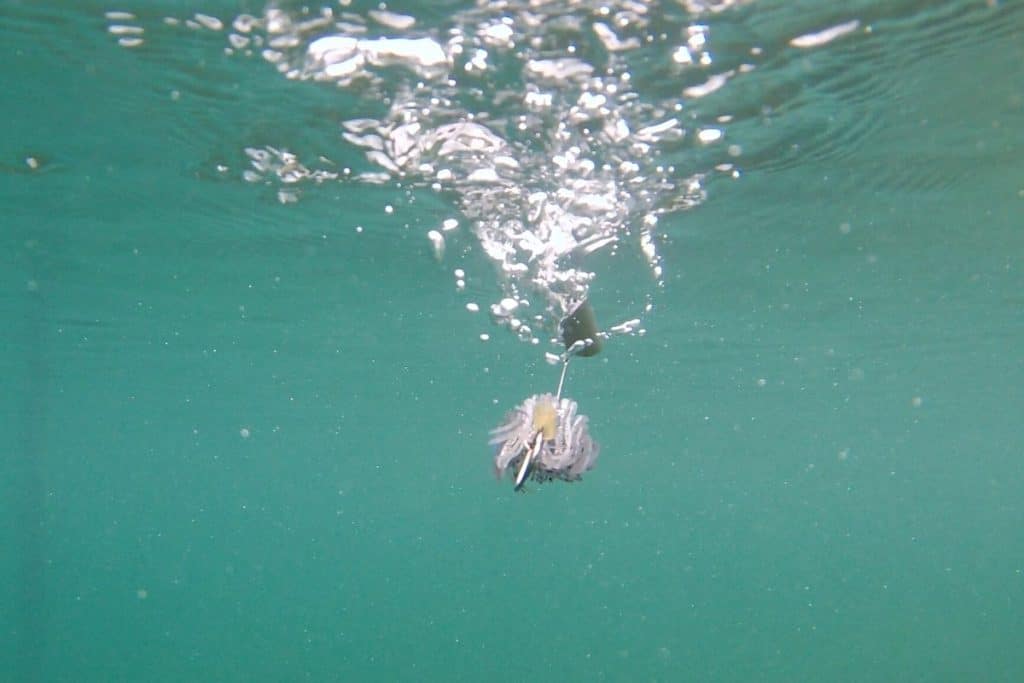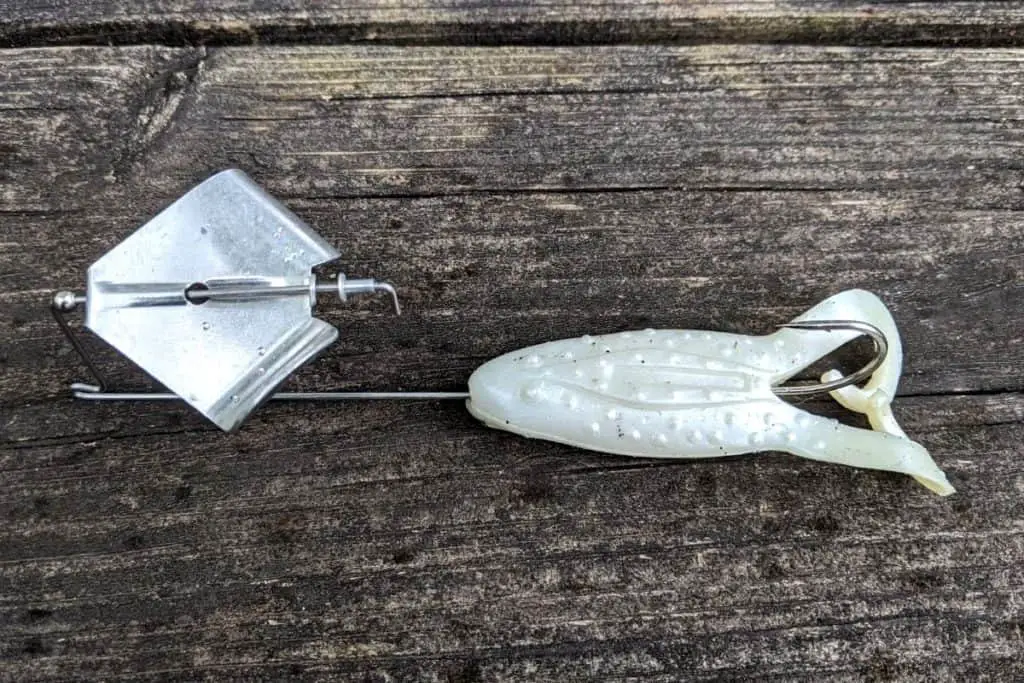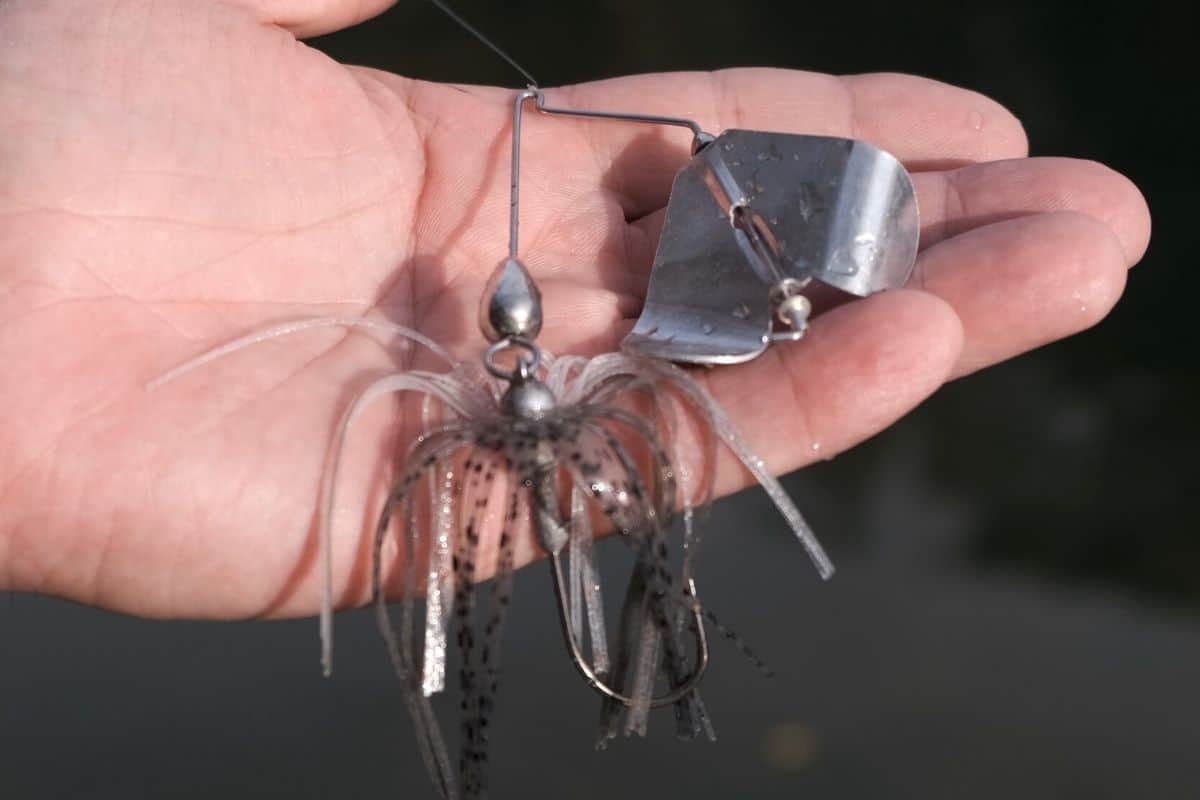Buzzbaits are bass fishing lures that have been around for a long time. Newer and flashier topwaters have pushed the buzzbait to the background. Savvy bass anglers know that this odd-looking lure can produce big bags of bass when you know what to look for.
Buzzbaits can be thrown most of the year. These topwaters excel when coming over surface clutter that can hang up other lures. Anytime an angler wants to mimic prey species fleeing a predator on the surface, a buzzbait can be used.
Identifying the cover and conditions that a buzzbait is best suited for will build your confidence in this special topwater lure.
Traditional Buzzbait Thinking Limits This Lure’s Potential
You may have heard that buzzbaits are only suited for hot weather. Or that they are best fished at night.
While these conditions are good for buzzbait fishing, this lure is much more versatile than just those two situations.
Buzzbaits can catch huge bass when water temps are below 50 degrees and all throughout the day – even in direct overhead sunlight.

Understanding What a Buzzbait Imitates Make Situations to Use One Clear
At first glance, a buzzbait looks like nothing a bass would eat. Ever.
The design and shape of the lure does not match any living creature I have ever seen.
The key is in the commotion.
The blades of a buzzbait disturb the water and add sound that curious bass are soon made aware of. The key word here is “curious.” Bass are very curious and will come and investigate almost anything that piques their interest. I have seen this over-and-over again when filming underwater.
But just because they investigate doesn’t mean they will eat it. Unless we can trigger their feeding instincts.
That is where a buzzbait can shine.
Fleeing bait, or fleeing prey, is about the strongest trigger that gets a bass to go from lethargic and noncommittal to chomping and chasing. They can’t help it.
Think about the range of creatures that would create a disturbance on the water’s surface.
Fleeing minnows, skipping shad, swimming frogs, insects, birds that have stumbled into the water, snakes, and mice are all examples. The list of animals that would find themselves in the water or fleeing a predator is extensive.
Now, think about each of the aforementioned situations.
Some creatures, like a snake, are going to create the smallest surface disturbances. A struggling bird, however, might cause quite a ruckus.
Choosing a Buzzbait Based on Prey and Water Clarity
In clear water, I almost always use a smaller profile buzzbait. Bass are visually oriented in clear water and getting a good look at the lure is not something I want.
Besides a smaller overall profile, speed is also key. The clearer the water, the faster the retrieve. The only exception here is during lowlight periods. At that point, I will often use a slower, churning type of retrieve.
If the only buzzbaits you own are larger in size, try removing some of the strands from the skirt or taking the skirt off the lure altogether and replace it with a plastic trailer.
Imitating minnows with small buzzbaits is a favorite tactic of mine.
If the prey you are attempting to imitate is larger, like a bullfrog. Then upscaling your buzzbait selection is a good choice.
Buzzbaits Shine When There is Some Surface Clutter
Think about fishing in the fall.
Our favorite lakes, ponds, and rivers can have endless leaves and pine needles floating on the surface.
Topwaters that use treble hooks dangling below them are almost worthless in this situation. The hooks catch the smallest debris and hamper the action of the lure to the point of it being a wasted cast.
Bass fishing is a numbers game. The more casts the more likely we are to get the bait in front of a bass.
The upturned hook of a buzzbait is ideal for some surface clutter.
It will come right over and through situations where other topwaters struggle.

Buzzbaits Excel When Bounced and Banged into Cover
The more “stuff” you can run a buzzbait into and along the better.
Bang it into a stump. Let it smack a rock. Make those blades churn alongside a dock post.
A large percentage of the bites that we get as bass anglers are not because a fish is hungry, but because they react.
If someone flicks their hands in your face you are going to react. A bass can only react with its mouth. This is why reaction strikes are so important to understand and utilize.
A buzzbait gurgling along the surface may draw the attention of a curious bass. They may even follow it. When that lure suddenly changes directions and bounces into something is the time when a strike is likely.
The lure should also be twitched during its retrieve. Even if nothing is around to bounce it into, the erratic motion will often get the bass to react. This is especially true when bringing the buzzbait through open water.
Using a Buzzbait to Find Bass
When I am moving down the shoreline and need to locate bass quickly, a buzzbait is one of the lures that I choose.
Earlier, we talked about the natural curiosity of bass. A buzzbait stimulates that curiosity and they often come to see what it is.
When I am using a buzzbait to locate fish, I pay close attention to the lure. Do I see a small swirl behind it? Do I notice the bass following and then turn away? Is there fish that slap at it?
In each of these scenarios, I may not catch the fish, but it has revealed itself.
When using the buzzbait as a searching tool that is exactly what I want to happen. Once I know there are bass in the area I can alter my lures and presentations to those that may be more suited for the situation.
A buzzbait is a powerful searching tool that is often forgotten about.
(Here is another article on locating bass.)

Alter The Profile of the Buzzbait When It’s Windy
When the wind is putting a little ripple on the water buzzbaits can produce big.
The added disturbance from the wind keeps bass from getting a great look at the lure. The food chain is also more active when the wind is present.
Microorganisms get kicked up in the shallows and attract small baitfish. These prey species in turn attract larger predators.
Many anglers will shy away from buzzbaits in the wind because they are hard to throw. The blades in combination with a full skirt hang up like a kite and frustrate anglers of all skill levels.
An easy fix is to remove the skirt completely. The buzzbait will still catch fish without a skirt.
If it looks too strange for your liking, replace the skirt with a slender profile soft plastic. Something like a straight-tail worm or jerkbait works nicely. Another popular option is to use a plastic frog, like on the Strike King Toad Buzz.
(Here is an article on fishing in the wind.)
Final Thoughts
The buzzbait is more versatile than we often give it credit for.
And you may be the only angler on the lake using one, which is always an added bonus.
Be safe out there and make sure to encourage someone today. You never know how you may change their life forever.
Isaiah 6:8

